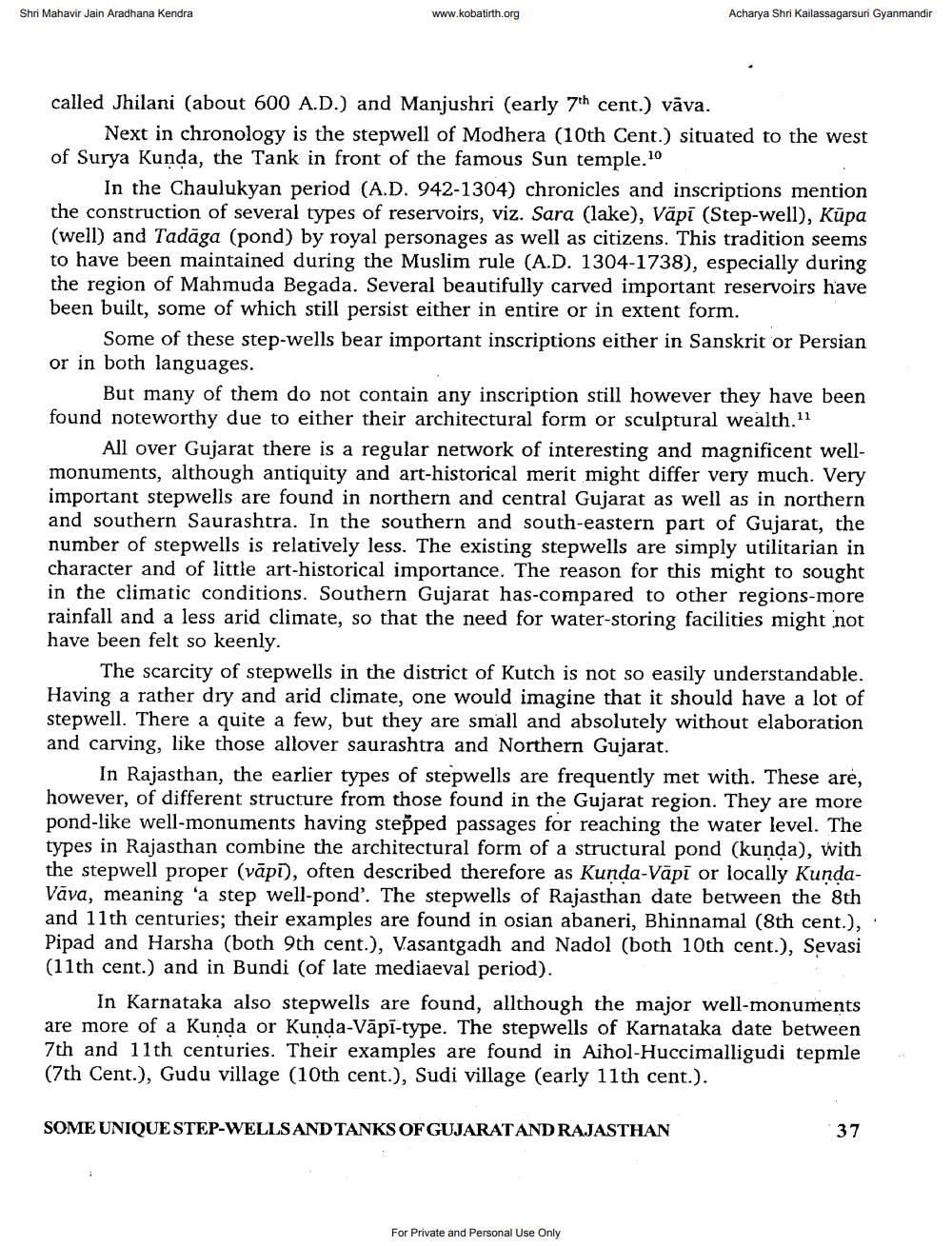________________
Shri Mahavir Jain Aradhana Kendra
www.kobatirth.org
Acharya Shri Kailassagarsuri Gyanmandir
called Jhilani (about 600 A.D.) and Manjushri (early 7th cent.) vāva.
Next in chronology is the stepwell of Modhera (10th Cent.) situated to the west of Surya Kunda, the Tank in front of the famous Sun temple.10
In the Chaulukyan period (A.D. 942-1304) chronicles and inscriptions mention the construction of several types of reservoirs, viz. Sara (lake), Väpi (Step-well), Küpa (well) and Tadāga (pond) by royal personages as well as citizens. This tradition seems to have been maintained during the Muslim rule (A.D. 1304-1738), especially during the region of Mahmuda Begada. Several beautifully carved important reservoirs have been built, some of which still persist either in entire or in extent form.
Some of these step-wells bear important inscriptions either in Sanskrit or Persian or in both languages.
But many of them do not contain any inscription still however they have been found noteworthy due to either their architectural form or sculptural wealth.11
All over Gujarat there is a regular network of interesting and magnificent wellmonuments, although antiquity and art-historical merit might differ very much. Very important stepwells are found in northern and central Gujarat as well as in northern and southern Saurashtra. In the southern and south-eastern part of Gujarat, the number of stepwells is relatively less. The existing stepwells are simply utilitarian in character and of little art-historical importance. The reason for this might to sought in the climatic conditions. Southern Gujarat has compared to other regions-more rainfall and a less arid climate, so that the need for water-storing facilities might not have been felt so keenly.
The scarcity of stepwells in the district of Kutch is not so easily understandable. Having a rather dry and arid climate, one would imagine that it should have a lot of stepwell. There a quite a few, but they are small and absolutely without elaboration and carving, like those allover saurashtra and Northern Gujarat.
In Rajasthan, the earlier types of stepwells are frequently met with. These are, however, of different structure from those found in the Gujarat region. They are more pond-like well-monuments having stepped passages for reaching the water level. The types in Rajasthan combine the architectural form of a structural pond (kunda), with the stepwell proper (vāpī), often described therefore as Kunda-Vāpī or locally KundaVāva, meaning 'a step well-pond'. The stepwells of Rajasthan date between the 8th and 11th centuries; their examples are found in osian abaneri, Bhinnamal (8th cent.), Pipad and Harsha (both 9th cent.), Vasantgadh and Nadol (both 10th cent.), Sevasi (11th cent.) and in Bundi (of late mediaeval period).
In Karnataka also stepwells are found, allthough the major well-monuments are more of a Kunda or Kunda-Vāpī-type. The stepwells of Karnataka date between 7th and 11th centuries. Their examples are found in Aihol-Huccimalligudi tepmle (7th Cent.), Gudu village (10th cent.), Sudi village (early 11th cent.).
Jualal.
SOME UNIQUE STEP-WELLS AND TANKS OF GUJARATAND RAJASTHAN
37
For Private and Personal Use Only




